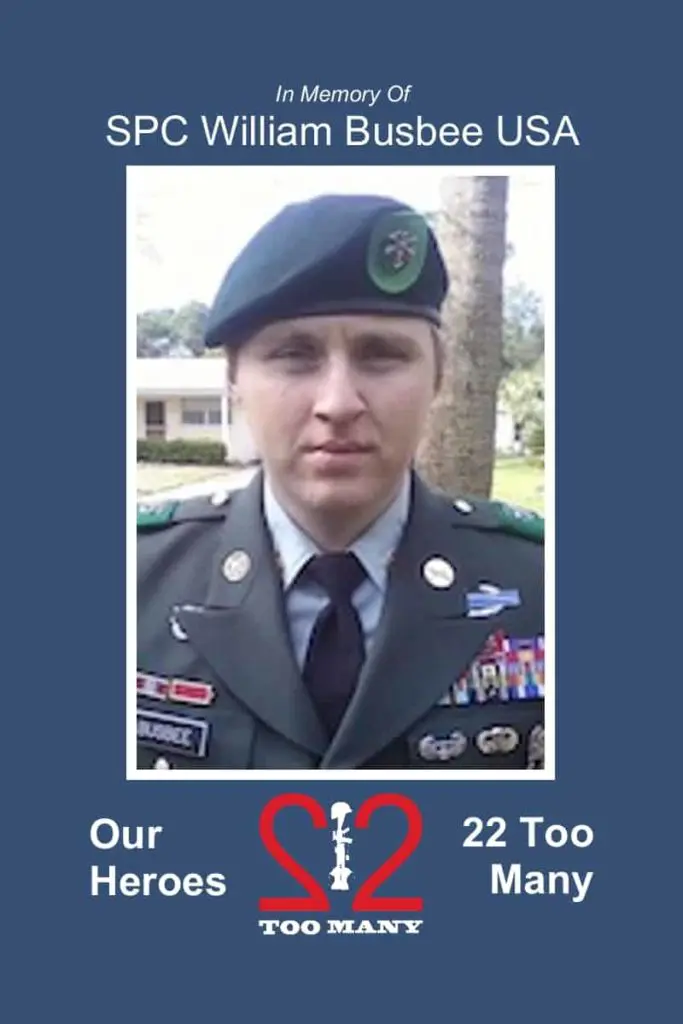“I was there for his first breath, and his last,” she said. “Now my daughters and me, we have to deal with what he was going through.” – Libby, William’s mom, quoted in Guarkian.Co.UK
Report: A veteran commits suicide every 80 minutes
by Randal Yakey
The News Herald
November 25, 2012
CALLAWAY, Fla. — Libby Busbee pounded on the window of her son’s maroon Dodge Charger as he sat in the driveway of their home earlier this year. Locked inside his car, U.S. Army Spc. William Busbee sat with a .45-caliber gun pointed to the side of his head.
“Look at me,” his mother cried out as she to tried and get her son’s attention. “Look at me.”
He wouldn’t look.
He stared out the front windshield, distant, said Libby Busbee, relating the story from an apartment complex in Callaway.
“I kept yelling, ‘Don’t you do this. Don’t do it.’ He wouldn’t turn his head to look at me,” she said, looking down at the burning cigarette in her hand.
A 911 call was made. The police pulled her away from the car.
William, Libby Busbee’s 23-year-old son, was talking with a police officer when he fired a shot through the front windshield of his car, according to the police report.
The police recoiled. William rapped on the window in apparent frustration, the report indicated.
Then the second shot was heard.
“I knew that was the one,” said Libby Busbee.
William Busbee took his life in March with his mother and sisters looking on.
According to a Veterans Affairs report this spring, a veteran commits suicide every 80 minutes. More than 6,500 suicides have occurred since the wars in Iraq and Afghanistan began.
For every service member who dies in battle, 25 veterans die by their own hands.
According to a Pentagon report, more American active service members have killed themselves in the first six months of 2012 than in the first six months of any of the previous 11 years, The Associated Press reported.
The report reveals 154 service members killed themselves in the first 155 days of 2012 alone. The number of deaths by suicide is 50 percent higher than combat deaths in Afghanistan during the same period and an 18 percent increase over active service member suicides in the first six months of 2011.
And, while only 1 percent of Americans have served in the wars in Afghanistan and Iraq, veterans of these conflicts represent 20 percent of all suicides in the United States, the VA reported.
Libby Busbee said when her son returned home, he didn’t leave the war behind.
“He saw horrible things — his friends dying,” she said. “The people over there were constantly attacking them. He even said the kids would be with them when they attacked.”
William Busbee was in the U.S. Army Special Forces, airborne and the Army Rangers.
“He told me how he picked up the body parts and loaded them onto a helicopter so their families would have something to bury,” she said.
She said her son had tried to commit suicide in Pesh Valley of Afghanistan. “He told me, ‘Momma, the William you knew died over there,’” she said.
On his return home, “He couldn’t be in the dark — at all. He’d flip out in the dark,” she said. “He was sleepwalking and they gave him 400 milligrams of Seroquel, they gave him Paxil, Klonopins. They had him on . a lot of stuff. I don’t think he knew which way to go.”
“When he would have his nightmares he would stand right up staring at me,” she said. “He would say, ‘Who are you?’”
It was as though her son was not inside his body at times, she said.
“It was the medications,” Libby Busby said. “That caused hallucinations.”
She stared out across the green patch of lawn across from her apartment as her daughters played inside.
“We thought he was happy and then he killed himself right in front of us,” she said.
Deb Tainsh Of Panama City Beach has become friends with Libby Busbee. Tainsh has been a fighter against the silence surrounding veterans affairs issues.
Tainsh and her husband, David, are the parents of U.S. Army Sgt. Patrick Tainsh, who was killed in Iraq in 2004. They are the founders and executive directors of Bereaved Military Families of America & Hearts for Military Heroes Veterans Assistance Program, a Florida all volunteer not-for-profit organization.
Tainsh traveled to Washington, D.C., to rally more support for veterans in the Gulf Coast area. She was unable to get to Gen. Eric Shinseki, secretary of the Department of Veterans Affairs, but she did make contact with his staff.
“The Veterans Administration was supposed to get 1,900 mental health professionals and a couple were to be coming to Panama City,” Tainsh said. “What has become of the them?”
In April, Shinseki announced the increase in mental health care workers would be 1,600. The VA said it was moving quickly to address this top priority, but they are not here yet.
Tainsh has admitted she feels anger at the number of suicides she sees among young veterans.
“Like I told the director of the VA Gulf Coast, it is a monster out of control,” Tainsh said. “They are not prepared for the number of veterans.”
Tainsh said it was about leadership and doctors who work in the hospitals.
“There is a lack of professional personnel to deal with the veterans,” she said. “An example of that is our Delwood Clinic here in Panama City.”
“There was a professional mental health doctor there who left in the past several months and I have heard from a number of our local veterans that hated to see him go because he was one of the best,” she continued. “I learned later that he left because he could not deal with the volume.”
That doctor declined to speak with The News Herald.
Delwood Chief Managing Officer Robert Mishra agreed there is a shortage of psychiatrists at Delwood.
“We have two psychiatrists and two nurse practitioners,” he said. “There is a shortage out there.”
Mishra said the veterans clinics are having trouble retaining qualified help. “The private sector pays more.”
Edwin R. Ailes, president and CEO of Life Management Center of Northwest Florida, said the rise in suicides is troubling but probably will not subside since the number of veterans coming home from war continues.
“We are seeing people requesting help that have military experience coming to Life Management Center,” Ailes said. “And sadly this will go on for a long time. We still see persons with PTSD and suicidal thinking from the Vietnam era and we’re relatively certain we will see this well into the future with persons who have served in Iraq and Afghanistan.”
Ailes also noted that family members and friends of suicide victims are left with feelings of anger, sadness and guilt. He believes the experiences of the combatant are unique to them and they often become reclusive.
“Witnessing combat is not normal life,” said Ailes. “Witnessing tragedy is not normal life.”
Ailes said traumatic events are constantly being repeated in the service member’s mind.
“It is the traumatic event over and over again,” Ailes said. “It is a constant battle within.”
Ailes, who did not wish to comment on the Busbee case specifically, said mixing drugs and taking too much of one type of drug could be detrimental to an individual’s health. Overdoses of prescribed medicine can add to a person’s psychological problems, he said.
Libby Busbee continues to do the best for her daughters. But she wonders how long the impressions they had of that day William Busby took his life will continue to impact their lives. She smiles as guests enter her home, a smile that struggles.
During a recent interview, she sifted through the bottle of pills in a plastic bag and looked at the labels from three different pharmacies in three different states.
She wonders what could have been for her son. She doesn’t believe he got the help he deserved.
She has saved a lot of the belongings her son left behind — the uniform with U.S. Army Special Forces badge, a Rangers badge and Airborne badge. She doesn’t know what all the metals mean.
On his last day, William Busbee had his uniform cleaned and pressed. She keeps the uniform hanging in a closet. She rarely takes it out.
She has saved several of the last text messages she received from her son on the day he killed himself. One still haunts her to this day: “I love you.”
William Busbee had numerous drugs, or the metabolites of drugs, found in his body after his death. He had prescriptions for some of these drugs from three different pharmacies in three different states.
Present in the body: Tramadol (pain reliever), bupropion (antidepressant), paroxetine (anti-anxiety), alpha-hydroxyalprazolam (metabolite of alprazolam, anti-anxiety/panic disorder), cannabinoids (marijuana), oxycodone (pain reliever)
Prescribed but not present: Seroquel (schizophrenia/bipolar disorder), Paxil (antidepressant), Prazosin (high blood pressure), clonazepam (anti-anxiety), ondansetron (anti-nausea), cyproheptadine (allergies), Percocet (pain reliever)

